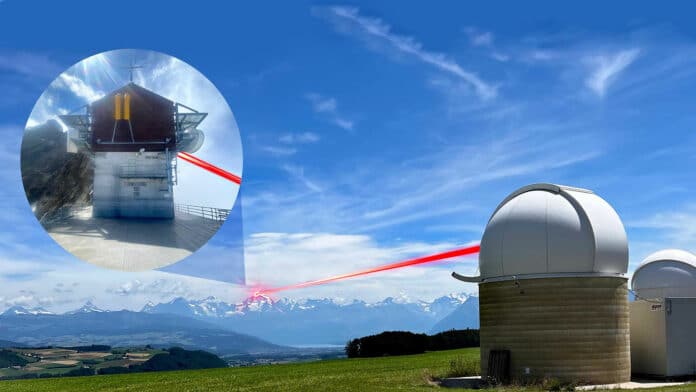Researchers at ETH Zurich and their European partners have successfully transmitted several tens of terabits of data per second using lasers in Switzerland, despite a huge amount of disruptive air turbulence.
To achieve this milestone, the European Horizon 2020 project partners took a significant leap forward in establishing a satellite optical communication link through a successful test conducted between the alpine mountain peak, Jungfraujoch, and the Swiss city of Bern.
Although the laser system was not directly tested with an orbiting satellite, they accomplished high-data transmission over a free-space distance of 53km (33 miles). In the future, this technology will make it possible to create backbone connections via near-Earth satellite constellations that are significantly less costly than deep-sea cables.
“For optical data transmission, our test route between the High Altitude Research Station on the Jungfraujoch and the Zimmerwald Observatory at the University of Bern is much more challenging than between a satellite and a ground station,” explains Yannick Horst, the study’s lead author.
The backbone of the Internet is formed by a dense network of fiber-optic cables, each of which transports up to more than 100 terabits of data per second between the network nodes. The intercontinental connections are established through deep-sea networks, which is an enormous expense – a single cable across the Atlantic requires an investment of hundreds of millions of dollars. Undersea cables are expensive, labor, and time-consuming to deploy.
Wireless telecommunications would be far simpler and cheaper. Elon Musk’s Starlink is a network of more than 2,000 satellites orbiting close to the Earth that provides internet access to virtually every corner of the world. However, transmitting data between satellites and ground stations uses radio technologies, which are considerably less powerful. Like a wireless local area network (WLAN) or mobile communications, such technologies operate in the microwave range of the spectrum and thus have wavelengths measuring several centimeters.

In contrast, laser optical systems operate in the near-infrared range with wavelengths of a few micrometers, which are about 10,000 times shorter. As a result, they can transport more information per unit of time. However, using lasers comes with its challenges, too.
The laser beam travels through the dense atmosphere near the ground. In the process, many factors influence the movement of the light waves and, consequently, also the transmission of data. The shimmering of the air caused by thermal phenomena disrupts the uniform movement of light and can be seen on hot summer days by the naked eye.
To prevent these errors, researchers deployed a microelectromechanical system (MEMS) chip with a matrix of 97 tiny adjustable mirrors. The mirrors can correct the phase shift of the beam at its intersection surface along the currently measured gradient 1,500 times per second, ultimately improving the signals by a factor of about 500. This improvement was essential in achieving a bandwidth of 1 terabit per second over a distance of 53 kilometers, researchers say.
“Our system represents a breakthrough. Until now, only two options have been possible: connecting either large distances with small bandwidths of a few gigabits or short distances of a few meters with large bandwidths using free-space lasers,” said Professor Jürg Leuthold.
Additionally, the performance of 1 terabit per second was achieved with a single wavelength. In future practical applications, the system can be easily scaled up to 40 channels and thus to 40 terabits per second using standard technologies.
Scaling up is not something Leuthold and his team will be concerning themselves with. There is one part of the work that the ETH Zurich scientists will continue to pursue: In the future, the new modulation format they developed is likely to increase bandwidths in other data transmission methods where the energy of the beam can become a limiting factor.
Journal reference:
- Yannik Horst, Bertold Ian Bitachon, Laurenz Kulmer, Jannik Brun, Tobias Blatter, Jean-Marc Conan, Aurélie Montmerle-Bonnefois, Joseph Montri, Béatrice Sorrente, Caroline B. Lim, Nicolas Védrenne, Daniel Matter, Loann Pommarel, Benedikt Baeuerle, and Juerg Leuthold. Tbit/s line-rate satellite feeder links enabled by coherent modulation and full-adaptive optics. Light: Science & Applications, 2023; DOI: 10.1038/s41377-023-01201-7
